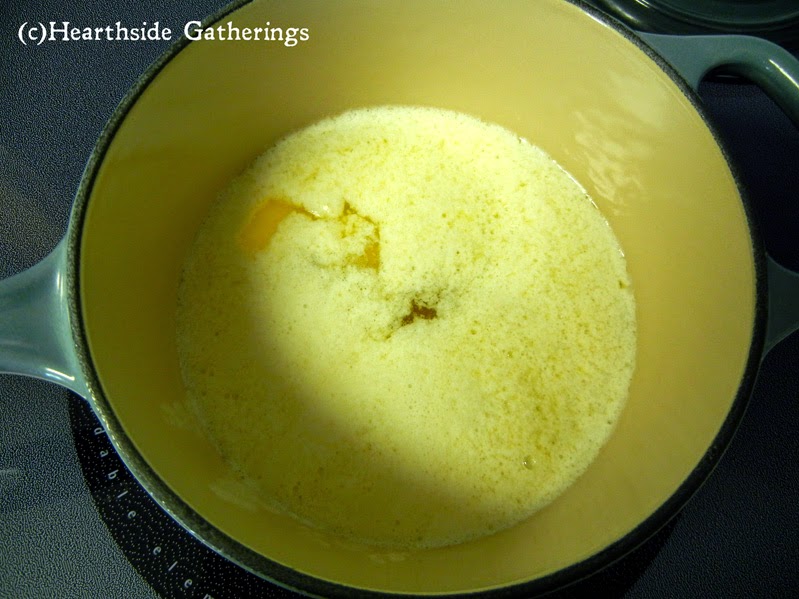Now that I can't eat regular butter without feeling like a nauseated bloated cow, I have a LOT of butter in my freezer looking for a reason to live. (Note: allow frozen butter to come to room temp before clarifying.)
Enter: clarified butter.
The process is easy enough: just heat the butter on the stove, skim off the white whey foam, and leave the casein in the bottom of the pan. Knowing that those proteins give me problems, but still wanting to use butter for cooking, I thought to myself, 'Self, clarified butter may be an option!' After doing a little internet research, I felt confident to try making it myself.
I set to work clarifying the butter:
I melted four sticks (2 cups/16 ounces) by cutting it into pieces and turning the burner on low while I did a few other kitchen tasks. Butter melts quickly, so it didn't take long for the pieces to melt and the whey to float to the top.
Look at all of that whey!
I skimmed out most of it, and I learned that you'll always scoop a small amount of butter out along with the whey, no matter how careful you are. Sad, but true. You also have to be careful not to stir the butter and mix together everything that you've just separated.
Anyway, it's not important to skim all of the whey off, we'll get it in a minute.
Line mesh strainers with at least four layers of cheesecloth. More layers will catch more impurities, so it's best to not be stingy here. Set the strainers over a large bowl with a pour spout and pour the butter through the strainer.
As you can see, the first strain still left some whey.
I also couldn't see any casein in the bottom of the pan before I poured it, so I poured it all through. It was only after I had it in the clear glass bowl that I could see a thin layer of a more solid substance at the bottom that was the casein.
 |
| You can see the brighter color of solids at the bottom--I circled it in the photo below. |
I lined another mesh strainer with eight layers of cheesecloth this time, and poured the contents through the second strainer, holding back once I saw the layer of casein at the bottom. Only a very small amount made it into the second strain, and no whey made it through.
But the real test came when I made dinner--I fried chunks of chicken in the butter, made buttered noodles, and boiled up some buttered peas. It might seem like butter overkill, but if I couldn't handle that, I'd have known quickly. You can see that the butter melted clear, which was a great sign of lack of impurities.
The chicken cooked up beautifully, with that perfect brown color, and the butter didn't smoke and burn like it normally does with the impurities.
The taste was the familiar butter flavor that I love. And I'm happy to report that I didn't feel bad that night, and still felt well the following morning. I think this is going to work! My frozen butter now has a reason to live again.
I've yet to try baking with clarified butter, but it'll be in my to-do list in the next few weeks. I'll pass along results and any good recipes.
One thing to note: storing the clarified butter in a jar like this is not the easiest method for getting butter out. I've purchased these molds on Etsy from Cannaware. You can see that not only do they make sticks of butter like you can buy at the store, but they also have tablespoon measurements on the side to make life easier. After I clarify my butter, I can make them into sticks for easier storage, access, and measuring. Win!












No comments:
Post a Comment
Thanks for your comment! Your input is appreciated. Don't worry, it'll post soon. Have a good day!